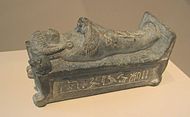This is an old revision of this page, as edited by Furius (talk | contribs) at 02:16, 1 December 2016 (removed Category:People of the Eighteenth Dynasty of Egypt; added Category:Princes of the Eighteenth Dynasty of Egypt using HotCat). The present address (URL) is a permanent link to this revision, which may differ significantly from the current revision.
Revision as of 02:16, 1 December 2016 by Furius (talk | contribs) (removed Category:People of the Eighteenth Dynasty of Egypt; added Category:Princes of the Eighteenth Dynasty of Egypt using HotCat)(diff) ← Previous revision | Latest revision (diff) | Newer revision → (diff) For other persons named Thutmose (Thutmosis, Djhutmose) see Thutmose (disambiguation).| Thutmose | |
|---|---|
 Prince Thutmose's schist recumbent bier Prince Thutmose's schist recumbent bier | |
| Occupation | Prince of Egypt |
| Parent(s) | Pharaoh Nebmaatre Amenhotep III Queen Tiye |
| Relatives | Akhenaten (brother) |
Thutmose (or, more accurately, Djhutmose) was the eldest son of pharaoh Amenhotep III and Queen Tiye, who lived during the Eighteenth dynasty of Egypt. His apparent death led to the reign of Akhenaten, his younger brother—as the successor to the Egyptian throne—and the intrigues of the century leading up to Ramesses II, the start and ultimately the failure of Atenism, the Amarna letters, and the changing roles of kingdom's powers.
Life

Prince Thutmose served as a priest of Ptah in ancient Memphis. His full royal titles are given in the sarcophagus of his pet cat: "Crown Prince, Overseer of the Priests of Upper and Lower Egypt, High Priest of Ptah in Memphis and Sm-priest (of Ptah)." A small schist statuette of the prince as a miller is in the Louvre Museum "while a recumbent mummiform schist figure is in Berlin." Prince Thutmose is best remembered for the limestone sarcophagus of his cat, Ta-miu (she-cat), now in the Cairo Museum. The schist statuette of Thutmose is inscribed on three sides with this text:
- "(right)...the king's son the sem-priest Djhutmose; (left) I am the servant of this noble god, his miller; (front) Incense for the Ennead of the western necropolis."
The cat sarcophagus of Prince Thutmose conclusively establishes that he was indeed the eldest son of Amenhotep III, since it provides his then current title of 'Crown Prince.' Thutmose is also attested by a total of 7 pairs of calcite and pottery vases in the Louvre.
Prince Thutmose disappears from the public records and appears to have died some time during the third decade of Amenhotep III's kingship, fairly late. In his place, his younger brother Amenhotep IV, better known as Akhenaten, succeeded to the throne.
Freud's 20th century interpretation
In his 1939 book Moses and Monotheism Sigmund Freud presented the idea that Crown Prince Thutmose's younger brother Akhenaten was associated with the Biblical character Moses. The idea was more recently (1998) reconsidered by Egyptologist Jan Assmann in Moses the Egyptian.
The schist recumbent bier
The 10.5 centimetres (4 in) schist recumbent mummiform bier has Thutmose prone with the Ba, Soul Bird upon his lower breast. The sides of the small statuette contain the following hieroglyphs, recording him as 'S-M Thoth-MS-S ', "True of Voice" '–SM (priest?) Tutmosis, "True of Voice"-("deserving", worthy, or "venerable").| |
References
- Aidan Dodson (1990). "Crown Prince Djhutmose and the Royal Sons of the Eighteenth Dynasty". Journal of Egyptian Archaeology. 76. p.88
- ^ Dodson, JEA 76, p.88
- Aidan Dodson & Dyan Hilton, The Complete Royal Families of Ancient Egypt, Thames & Hudson (2004), p.157
- Arielle Kozloff & Betsy Bryan, "Royal and Divine Statuary," Egypt’s Dazzling Sun: Amenhotep III and his World, (Cleveland, 1992), p.425, fig.XIV.1
- Dodson, JEA 76, p.87
- Dodson & Hilton, p.157
- Exhibition Item No. 15, Prince Thutmose ("Thutmose V") on a Bier, Pharaohs of the Sun, Freed, Markowitz, D'Auria, c. 1999 (also from 1999 USA exhibit tour), Exhibit catalog, p. 205; (last 7 hieroglyphs: S-M-Ibis(Thoth)-MS-S-Rudder-Plinth);( Note: the 'X' denotes, the evil, danger, or 'untimelyness' of his death).